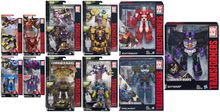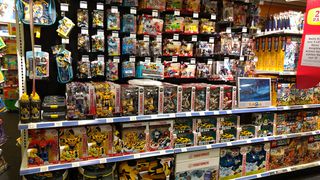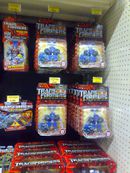Wave
From Transformers Wiki
| This article is about the concept of multiple toys being released at the same time. For the Multiforce Autobot, see Waver. |
- In TakaraTomy's markets (mainly Japan), where toys have an official release date, all toys released under the same toyline branding that are first released on the same day are part of the same wave.
- In Hasbro's markets, where toys typically (but not always) don't have an official "street date" and are released as part of standardized price points (or size classes) which constitute an "assortment", a wave is a lot shipment (a "case") of several different toys released under the same price point that differs from a previous or subsequent shipment of the same price point in terms of its specific content.
Because of those very contrasting distribution systems, there are many myths and misconceptions surrounding the "wave" system (primarily concerning Hasbro's markets), with the adult fans' idea of a "wave" often differing drastically from the actual established concept used within the toy industry, often as a consequence of misapplying the Japanese concept to Western toy manufacturers. However, the official system isn't flawless either, and there are many inconsistencies, discrepancies and oddities that complicate things further.
Contents |
TakaraTomy
This one is actually pretty straightforward: The Japanese toy distribution system allows for manufacturers to ship every single product by itself, packaged in cases of its own, and retailers can order those toys individually, in quantities of their own choosing. The only exception to this are usually deliberate variants of a toy that are sometimes shipped in shared cases that contain both (or all) variants in a specific ratio, either in equal numbers or with one version being a rarer variant.
Additionally, in part owing to the comparatively small size of the country, the Japanese toy distribution system also allows for manufacturers to determine specific release dates for individual products. Retailers will receive the figures a few days (or even weeks) in advance, but won't be allowed to put them on the shelves until that date. At the moment, Saturdays are the most common "street dates" for Transformers toys.
It's very common for multiple toys from the same toyline to be released on the same date. In those cases, all those toys are considered to be part of the same wave. However, toys from other toylines (even when all of them are part of the larger Transformers franchise) are usually not considered part of the same wave, especially since the wave numbers will often differ between those different toylines. So, for example, wave 7 of TakaraTomy's version of the Studio Series and wave 3 of Siege were both released on April 27, 2019.
And that's it, really. Now as for Hasbro's markets, things are a loooot more complicated.
Hasbro
Generally, Western markets have a very different distribution system than Japan. Retailers are lazy, and rather than keeping track of every single individual product, they want everything as simple as possible. So instead of selling every single product separately to stores, manufacturers instead often offer them as standardized assortments, with every toy from the same assortment having to conform to the same mass and dimension limits so they can ship in standardized packaging and be sold under the same price point. This simplifies things considerably, since now retailers only have to keep track of assortments, rather than individual products. The manufacturer will then pre-select how many of each figure will be packed in a shipping case, which is based on estimates, past experiences with previous lines, and focus group testing. Over time, the manufacturer will change the exact composition of a case by changing the number of copies of the individual figures included in a case relative to one another, but also by adding new figures that weren't included in the previous shipments, and eventually phasing out older figures in favor of new ones. Every time the composition of a case changes, this is considered a different "wave".
Why waves? A history lesson
Although the original Transformers toy line (also known in retrospect as Generation 1) already had assortments, the "wave" system as we know it today didn't exist yet back then. In part due to its origins as imported toys from existing Japanese lines (primarily Diaclone and Micro Change), the early years of the Transformers line featured a plethora of different price points, many of them gimmick-specific.
Instead of waves, Hasbro would release the same toys under multiple different assortments, sometimes even within the same year. For example, the Autobot Cars were released under the assortment number 5750 in 1984, while in 1985, Hasbro distributed them under the assortment numbers 5765 and 5766, each of which contained some of the previous year's figures alongside some of the new figures that debuted in 1985. (There is a very unique exception to this, with some extremely late shipments of the 1984 assortment containing Skids in place of a second Mirage.) Likewise, the Mini Vehicles (or "Autobot Minicars", as they were called during the first year) were released under the assortment number 5700 in 1984, whereas they were re-released in 1985 with an additional Mini-spy figure (assortment number 5709), before yet another assortment (5710) added the new figures that debuted in 1985. Many other figures such as the Decepticon Planes, the Mini-Cassettes, the Triple Changers, the Dinobots or the Combiner limbs and torsos were also released under multiple assortment numbers, which stores had to order separately. This system continued all the way to the end of the original line's United States retail run in 1990, by which point the line was divided into the two major sublines Micromasters and Action Masters.
Like its predecessor, the Generation 2 line featured a wide variety of different gimmick-specific price points, many of them only consisting of a handful of different figures. Stores still had to order each price point separately, resulting in very complicated logistics for Hasbro's distribution department, vendors and retailers. However, in 1995, Generation 2 pioneered the first major change: The Go-Bots and Cyberjets assortments were the first price points that retained one singular assortment number (80181 for the Go-Bots, 80182 for the Cyberjets) despite adding and swapping out toys in subsequent shipments, although all of them were redecos of the initial figures (though marketed as separate characters). A fourth wave of the Go-Bots assortment was actually planned (which would have featured a full set of six entirely new figures), as were a second wave of the Laser Cycles (featuring new-character redecos of the wave 1 figures) and a second and third wave of the Auto Rollers (with new-character redecos of the wave 1 figures for wave 2, and two entirely new figures for wave 3). However, all of those ultimately fell victim to the cancellation of the Generation 2 line and remain unreleased.
In 1996, when Hasbro subsidiary Kenner took over the Transformers brand and launched the Beast Wars line, the "wave" system that had been tried out the previous year was turned into a new standard, while the complexity with all the various gimmick-specific price points was significantly simplified. Kenner streamlined the output of new product into a smaller number of price points (Basic, Deluxe, Mega and Ultra), with all toys being designed to fit into one of these price points. Like the Go-Bots and Cyberjets before them, the new assortments also continued to ship throughout the year and into the next one, and every once in a while, Hasbro/Kenner would change the case ratios by adding new figures, changing the number of copies per case for the older ones and eventually phasing out older figures entirely in favor of new ones. This was also the time when redecos and retools started to become a much more regular occurrence than they had been previously, including same-character redecos: Releasing a different version of an existing figure helped to increase the variety in a new case just as much as an entirely new figure would, without wasting the entire R&D budget for creating new sculpts. Essentially, this marked the birth of the "wave" system as we know it today, and indeed, not a lot has changed since then, other than the introduction of new price points (or renaming existing ones) for subsequent lines.
Now as for the term "wave" in reference to this concept, it appears that the fans used it earlier than Hasbro, even as early as the days of Beast Wars[1], while shipping cases for both Beast Wars and Beast Machines figures simply identified them as "assortments". The term "wave" first appeared on Hasbro shipping cases beginning with the 2001 Robots in Disguise toyline.
What is a wave? Fan misconceptions versus reality
When adult collectors think of "waves", a common misconception is that all the new toys released under different price points roughly around the same time constitute one wave. Basically, in this perception, a "wave" is a huge bulk of toys of all sorts of different sizes that all ship together; in other words, the way it's done in Japan. The absurdity of this misconception often becomes more and more apparent as time goes on, because it's not uncommon for the larger price points to have a lower turnover rate than the smaller ones, resulting in fewer distinct case assortments for the larger price points. This would occasionally result in incorrect perceptions such as "there are no Leaders in wave 4".In reality, however, each price point has its own waves, which are numbered independently from one another. Sometimes Hasbro aims for synchronicity between different price points, which doesn't exactly help matters (even though this doesn't always work out flawlessly in execution, since waves of different price points that are intended to ship at the same time might ultimately materialize at retail months apart), while other times, there is no "larger picture" at work, and eventually, the number of distinct waves between the various price points will diverge more and more as time goes on. This misconception was fueled in particular by the Combiner Wars line, which aimed for a wave synchronicity between the Legends, Deluxe and Voyager Class price points in order to have all members of a combiner team available at retail at the same time.
Another common misconception is that a wave by its very definition only consists of new figures. This was true for the European market up until a few years ago, and has been adopted by Hasbro on a global level for the Combiner Wars and Titans Return lines to some degree (see below for more on that); but for the most part, waves can and will always feature additional shipments of unchanged existing figures (sometimes unofficially referred to as "repacks" by some fans) alongside redecos, retools and entirely new figures. However, for the sake of simplicity, TFWiki.net's toy lists for multi-wave lines will only list the new figures that debut in a wave, while ignoring the various repeats of existing figures.
Pros and cons of the wave system
The wave system, and the assortment system in general, has its advantages, but also its flaws.On the upside, retailers don't have to track every individual figure separately, but only have to worry about stocking a much smaller number of separate assortments, while the manufacturer handles the specifics of how many of each figure are packed within a case. Stores don't have to worry about explicitly ordering new product because the manufacturer will eventually simply change the composition of a case and include the new product, i.e. shipping a new wave. And even if a store might have skipped a wave for whatever reason, that doesn't always mean the store will never stock the figures included in said wave, since those will often ship again in subsequent waves. Essentially, the wave system creates a significant simplification for retailers—at least in theory.
The downsides of the wave system are multifold: First of all, there is the ever-present problem of shelfwarmers. Despite all the experience and focus group testing, Hasbro cannot foresee the future, and there is always the possibility that certain figures included in a case won't end up being as popular as expected, resulting in larger supplies than there is demand for those figures. Conversely, other figures might turn out to be much more popular than expected, resulting in more demand than there is supply. This can be made worse if a figure that proves popular for whatever reason is shortpacked.
Another frequent observation is that stores will almost always, without fail, overstock the first wave of any given assortment, resulting in the wave 1 figures being much more common than figures that debut in later waves, with very few exceptions. Conversely, figures from the end of the line will be a lot less common, and might often even suffer from the infamous "tail end of the line" syndrome, where most retailers won't order the final wave(s) of an assortment anymore, resulting in those figures being very hard to find, limited to online retailers or international markets, or only being found at discounters.
In Europe, the situation was actually worse for a long time, since Hasbro adapted the wave system to European markets with one major change: Instead of including additional shipments of existing figures alongside the new figures in later waves, Hasbro divided waves rigidly so they would only ever include the newest figures. This resulted in much less variety within a case, an equally limited variety on store shelves (assuming the store didn't stock a new wave to accompany shelfwarmers from previous waves) and thus a higher chance of shelfwarmers. Particularly infamous instances include Armada Scavenger (who shipped in solid cases due to being the only new figure in his wave) and Deluxe Class Swindle and Bonecrusher from the 2007 Transformers movie line (who were both packed four per case, in a case that didn't include any other figures but those two). This also meant that a store that didn't get a specific wave would never stock any of the figures included in said wave. Hasbro eventually addressed this problem a few years ago by applying the wave system as it is used in the rest of the world to European markets as well, finally resulting in more variety on store shelves… but then applied the old "European" system to the rest of the world with the Combiner Wars line, with similar results as before.
Inconsistent wave numbering and competitive systems
In addition to regular, numbered waves, there are also so-called "revision" waves; for example, "wave 4" of any given assortment might be followed by "wave 4 revision 1" and "wave 4 revision 2" before being succeeded by "wave 5" proper. Sometimes such a revision wave is also referred to as something like "wave 4.5", but that labeling is most certainly unofficial.Now, one might reasonably assume that a "revision" will only include a different mix of existing figures, while a fully-fledged numbered wave will introduce at least one new figure, be it a redeco or a retool of an existing figure or an entirely new sculpt. That is not always the case, however: For example, Transformers: Prime Beast Hunters Cyberverse Legion Class Air Vehicon made his debut in "Wave 4 Rev. 1" of the Legion Class assortment, whereas waves 6, 7, 11 and 14 (according to the official wave numbering) of the 2015 Robots in Disguise toy line's One-Step Changer assortment didn't introduce any new figures. For the sake of convenience, TFWiki.net does not count those waves that don't contribute anything new, even if it means our wave count won't always match the official numbering.
While some online retailers such as Entertainment Earth will use this ongoing wave numbering, others, such as competitor BigBadToyStore, use a variation, where the wave numbering of an ongoing line is often reset at the beginning of a new year. So, for example, "W4 15" (2015 wave 4) might not be followed by "W5 15" but by "W1 16" (2016 wave 1), although the very nature of the distribution system, where toys typically don't have an official "street date", means that "W1 16" might actually be found at retail as early as November 2015.Another system, which is used by wholesaler BBCW Distributors (and sometimes also by Hong Kong-based Robot Kingdom) and is printed on Hasbro shipping cases concurrently with the year-based wave numbering, is an alphanumeric numbering system following the assortment number. So, for example, the Robots in Disguise Warrior Class, which has the assortment number B0070, might have cases labeled "B0070AS00", "B0070AS01", "B0070AS02" etc. For cases intended for European markets, "AS" is replaced by "EU". For the last two digits, there doesn't seem to be a concise system as work, since labelings in the two-digit regions are known to exist (such as "EU50" or "EU66"), as are labelings that replace the second digit with a letter (e.h. "AS0G", "AS0H" etc.). Starting in late 2019, "AS" and "EU" were repleced with "5L", referring to the new worldwide multilingual packaging standard featuring five languages (English, French, German, Spanish and Portuguese).
References
- ↑ Possibly the oldest documented use of the term "wave" in this context made by Scott Mcallister at alt.toys.transformers on April 16, 1996.









